Art Deco
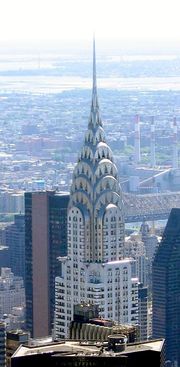
The Art Deco spire of the Chrysler Building in New York, built 1928–1930.
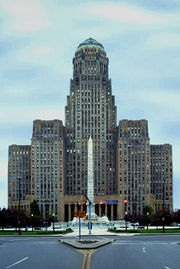
City Hall of Buffalo, New York, an Art Deco building.
|
Art Deco is an eclectic artistic and design style which had its origins in Paris in the first decades of the 20th century. The style "originated in the twenties"[1] and continued to be employed until after World War II. The term "art deco" "came into general usage soon after a 1966 exhibition" [2], referring to the 1925 Exposition Internationale des Arts Décoratifs et Industriels Modernes that was the culmination of high-end style moderne in Paris. Led by the best designers in the decorative arts such as fashion, and interior design, Art Deco affected all areas of design throughout the 1920s and 1930s, including architecture and industrial design, as well as the visual arts such as painting, the graphic arts and film. At the time, this style was seen as elegant, glamorous, functional and modern.
Art Deco moved away from the soft pastels and organic forms of Art Nouveau and embraced influences from many different styles and movements of the early 20th century, including Neoclassical, Constructivism, Cubism, Modernism, and Futurism.[3] Its popularity peaked in Europe during the Roaring Twenties[4] and continued strongly in the United States through the 1930s.[5] Although many design movements have political or philosophical roots or intentions, Art Deco was purely decorative.[6]
Art Deco experienced a decline in popularity during the late 1930s and early 1940s, but experienced a resurgence in the 1960s with the first book on the subject by Bevis Hillier in 1968[1] to coincide with the Minneapolis exhibition and continued with the popularization of graphic design in the 1980s. Art Deco had a profound influence on many later artistic movements, such as Memphis and Pop art.
Surviving examples may still be seen in many different locations worldwide, in countries as diverse as China (Shanghai), United Kingdom, Spain, Cuba, Indonesia, the Philippines, Argentina, Romania, Australia, Canada, New Zealand, India, Brazil, Colombia, and the United States (primarily in Miami Beach, Los Angeles, and New York City). Many classic examples still exist in the form of architecture in many major cities. The Empire State Building and Chrysler Building, both in New York City, are two of the largest and best-known examples of the style.
Contents |
History

After the Universal Exposition of 1900, various French artists formed an informal collective known as La Société des artistes décorateurs (the society of the decorator artists).[7] Founders included Hector Guimard, Eugène Grasset, Raoul Lachenal, Paul Bellot, Maurice Dufrêne, and Emile Decoeur. These artists heavily influenced the principles of Art Deco as a whole.[8]
This society's purpose was to demonstrate internationally the leading position and evolution of the French decorative arts. They organized the 1925[9] Exposition Internationale des Arts Décoratifs et Industriels Modernes (International Exposition of Modern Industrial and Decorative Art) in Paris,[10] which would feature French art and business interests.[8][11] The terms Style Moderne and Art Deco both derive from the exposition's title,[5] though Art Deco was not widely used until popularized by art historian Bevis Hillier's 1968 book Art Deco of the 20s and 30s.[1]
In the summer of 1969, Hillier conceived organizing an exhibition called Art Deco at the Minneapolis Institute of Arts,[12] which took place from July to September 1971. After this event, interest in Art Deco peaked with the publication of his 1971 book The World of Art Deco, a record of the exhibition.[13]
Sources and influences
The structure of Art Deco is based on mathematical geometric shapes.[14] It was widely considered to be an eclectic form of elegant and stylish modernism, being influenced by a variety of sources. The ability to travel and excavations during this time influenced artists and designers, integrating several elements from countries not their own. Among them were the so-called "primitive" arts of Africa, as well as historical styles such as Greco-Roman Classicism, and the art of Babylon, Assyria, Ancient Egypt,[14][15] and Aztec Mexico.[3]
Much of this could be attributed to the popular interest in archeology in the 1920s (e.g., the tomb of Tutankhamun, Pompeii, the lost city of Troy, etc.). Art Deco also drew on Machine Age and streamline technologies[16] such as modern aviation, electric lighting, the radio, the ocean liner and the skyscraper for inspiration.[3] Streamline Moderne was the final interwar-period development, which most thoroughly manifests technology and has been rated by some commentators as a separate architectural style.[17]
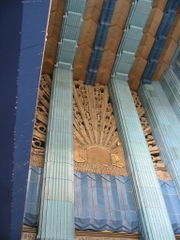
Art Deco design influences were expressed in the crystalline and faceted forms of decorative Cubism and Futurism.[18][18] Other popular themes in Art Deco were trapezoidal, zigzagged, geometric, and jumbled shapes,[15][19] which can be seen in many early pieces. Two great examples of these themes and styles are in Detroit, Michigan: the Fisher Building and the Guardian Building.[20]
Attributes
Art Deco was an opulent style, and its lavishness is attributed to reaction to the forced austerity imposed by World War I. Its rich, festive character fitted it for modern contexts, including the Golden Gate Bridge, interiors of cinema theaters (a prime example being the Paramount Theater in Oakland, California) and ocean liners such as the Île de France, Queen Mary, and Normandie. Art Deco was employed extensively throughout the United States' train stations in the 1930s,[21] designed to reflect the modernity and efficiency of the train. Art Deco made use of many distinctive styles, but one of the most significant of its features was its dependence upon a range of ornaments and motifs.[3]
The style is said to have reflected the tensions in the cultural politics of its day, with eclecticism having been one of its defining features.[3][15] In the words of F. Scott Fitzgerald, the distinctive style of Art Deco was shaped by 'all the nervous energy stored up and expended in the War'.[3][22] Art Deco has been influenced in part by movements such as Cubism, Russian Constructivism and Italian Futurism,[15] which are all evident in Art Deco decorative arts'.[8]
Materials and design
Art Deco is characterized by use of materials such as aluminium, stainless steel, lacquer, Bakelite, Chrome and inlaid wood.[10][14][15] Exotic materials such as sharkskin (shagreen), and zebra skin were also in evidence.[10][15][19][23] The bold use of stepped forms and sweeping curves (unlike the sinuous, natural curves of the Art Nouveau),[14][24] chevron patterns, the ziggurat, the fountain, and the sunburst motif are typical of Art Deco. Some of these motifs were ubiquitous — for example, sunburst motifs were used in such varied contexts as ladies' shoes, radiator grilles, the auditorium of the Radio City Music Hall, and the spire of the Chrysler Building.
Streamline Moderne


A parallel movement called Streamline Moderne, or simply Streamline, followed close behind. Streamline was influenced by the modern aerodynamic designs,[14] including those emerging from advancing technologies in aviation, ballistics, and other fields requiring high velocity. The attractive shapes resulting from scientifically applied aerodynamic principles were enthusiastically adopted within Art Deco, applying streamlining techniques to other useful objects in everyday life, such as the automobile. The Chrysler Airflow design of 1933 was commercially unsuccessful,[25] but the beauty of the design, being functional rather than simply tacked on ornamentation, provided the lead for more conservatively designed pseudo-streamlined vehicles.
Streamlining quickly influenced American and European automobile design and changed the look from the rectangular "horseless" carriages into sleek vehicles with sweeping lines, symmetry, and V-shapes that added to their mystique of speed and efficiency.[26] Nash Motors introduced the modern fully-unitized body (monocoque) design for the low-price market in 1941[27] that featured fastback “Slipstream” models with high prow-like hoods, and Art Deco "speed lines" in sweeping chrome grilles and parallel bar trim.[28] These aerodynamic-looking designs were applied by automakers and continued to be popular in the sellers' market after World War II.[29] These "streamlined" forms began to be used in the design of mundane and static objects such as pencil sharpeners, refrigerators,[14] and gas pumps.[30]
Art Deco celebrates the Machine Age through explicit use of man-made materials (particularly glass, stainless steel and the new plastics),[14] symmetry,[24] and repetition, modified by Asian influences such as the use of silks and Middle Eastern designs. It was strongly adopted in the United States during the Great Depression for its practicality and simplicity, while still portraying a reminder of better times and the "American Dream".[5]
Streamlining was geared towards simplicity, the idea that less is more. Eliminating elements that cluttered a given building, painting, or chair was the focus of this new development of streamlining. This simplicity is portrayed through the use of crisp, symmetrical geometric forms. Streamlining enables diverse furnishings to coexist seamlessly with in one space.
Consumer products
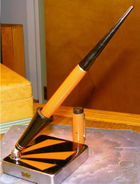
Art deco was a popular style used in consumer products such as furniture, china, lamps, cars, jewelry, watches, ash trays, and more.
Decline and resurgence
Art Deco slowly lost patronage in the West after reaching mass production, when it began to be derided as gaudy and presenting a false image of luxury. Eventually, the style was cut short by the austerities of World War II. Before destruction in World War II, Manila possessed many Art Deco buildings; a legacy of the American colonial past.
A resurgence of interest in Art Deco came first in the 1960s,[10][15][31] and then again in the 1980s with the growing interest in graphic design,[10] where its association with film noir and 1930s glamour led to its use in advertisements for jewelry and fashion and toiletries.[32]
Surviving examples
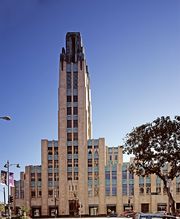
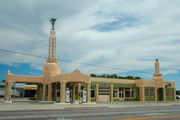
Americas
The United States has fine examples of Art Deco architecture. New York, Chicago, and Detroit have a great many deco buildings, the famous skyscrapers are the best known, but notable deco buildings can be found in various neighborhoods. Detroit's many examples of Art Deco architecture include the Fisher and Guardian Buildings both of which are National Historic Landmarks. Los Angeles, California, is also rich in Art Deco architecture, particularly along Wilshire Boulevard, a main thoroughfare that experienced a building boom in the 1920s. Notable examples include the Bullocks Wilshire and the Pellissier Building and Wiltern Theatre, built in 1929 and 1931 respectively. Both buildings underwent recent restoration.[33][34]
Miami Beach, Florida, has a large collection of Art Deco buildings, with some thirty blocks of hotels and apartment houses dating from the 1920s to the 1940s. In 1979 Miami Beach's Art Deco Historic District was listed on the National Register of Historic Places. Nearly all the buildings have been meticulously restored and painted in their original pastel colors.[35]
Fair Park, located in Dallas, Texas, is large collection of Art Deco structures. Much of the Art Deco heritage of Tulsa, Oklahoma remains from that city's oil boom days.[36] Houston, Texas has some surviving buildings, such as the Houston City Hall, the JPMorgan Chase Building, Ezekiel W. Cullen Building, and the 1940 Air Terminal Museum, though many are threatened by modern development.[37] In Beaumont, the Jefferson County Courthouse, Kyle Building and the First National Bank Building are some of the few Art Deco buildings still standing in the city.
Hoover Dam is a somewhat unusual example of Art Deco design. Dam guides frequently state that the design was to be Gothic, right down to the installation of gargoyles with water shooting out of their mouths.
Kansas City is home to the Kansas City Power and Light Building which completed construction in 1931. This building serves as a great example of the Great Depression and its effect on Art Deco construction. Original plans called for a twin tower to be built next to it on its west side. However, it was never built due to financial constraints. As a result, the 476 foot tower has a bare west side, with no windows. Other examples of Art Deco buildings in Kansas City include Municipal Auditorium (Kansas City), the Jackson County Courthouse (Kansas City, Missouri), Kansas City City Hall; and 909 Walnut.
Cincinnati, Ohio houses the Cincinnati Union Terminal, an Art Deco style passenger railroad station that opened in 1933. After the decline of railroad travel, most of the building was converted to other uses. It now serves as the Cincinnati Museum Center, which welcomes more than one million visitors per year and is the 17th most visited museum in the United States.[38][39] Cincinnati is also home to the Carew Tower, a 49-story Art Deco skyscraper built in 1931.
In 2005 the largest residential restoration project in the country and the largest collection of Art Deco buildings in New Jersey began at the 14 acre site of the former Jersey City Medical Center. The conversion of the national historic site to a residential enclave had as of 2009 been completed on three of the several buildings on the site.
One of the most famous surviving examples of the Art Deco style is the famous RMS Queen Mary, which is currently moored in retirement in Long Beach, California as a floating museum and hotel, a true lasting reminder to the past glory of the once numerous trans-Atlantic ocean liners, and to the Art Deco period.
Some of the finest surviving examples of Art Deco art and architecture are found in Cuba, especially in Havana. The Bacardi Building is noted for its particular style,[40] which echoes the classic themes of Art Deco. The style is expressed in the architecture of residences, businesses, hotels, and many pieces of decorative art, furniture, and utensils in public buildings, as well as in private homes.[13]
Another country with many examples of rich Art Deco architecture is Brazil, especially in Goiânia and cities like Cipó (Bahia), Iraí (Rio Grande do Sul) and Rio de Janeiro, especially in Copacabana. Also in the Brazilian Northeast — notably in countryside cities, such as Campina Grande in the state of Paraiba — there is a noticeable group of Art Deco buildings, which has been called “Sertanejo Art Deco” because of its peculiar architectural features.[41] The reason for the style being so widespread in Brazil is its coincidence with the fast growth and radical economic changes of the country during 1930-1940.
In Santiago, Chile, Hotel Carrera (no longer a hotel) is a very fine example of Art Deco architecture. Art deco buildings are also numerous in Montevideo, Uruguay, including the iconic Palacio Salvo, which was South America's tallest building when it was built in the late 1920s.
Europe
In London, the former Arsenal Stadium boasts the famous East Stand facade. It remains at the football club's old home at Highbury, London Borough of Islington, which was vacated in the summer of 2006. Opened in October 1936, the structure now has Grade II listed status and has been converted into flats. William Bennie, the man behind the project, famously used the Art Deco style in the final design which was seen as one of the most opulent and impressive stands in world football. The London Underground is also famous for many examples of Art Deco architecture.[42]
Valencia, Spain built profusely in Art Deco style during the period of economic bounty between wars in which Spain remained neutral. Particularly remarkable are the famous bath house Las Arenas, the building hosting the Rectorship of the University of Valencia and the cinemas Rialto (currently the Filmoteca de la Generalitat Valenciana), Capitol (reconverted into an office building) and Metropol.
As a result of the inter-war period of rapid development, cities in Romania have numerous Art Deco buildings, including government buildings, hotels, and private houses. The best representative in this regard is the capital, Bucharest, which, despite the wide-spread destruction of its architecture during Communist times, still has many Art Deco highlights, both on its main boulevards and in the lesser known parts of the city.[43][44][45] Ploiesti also has many Art Deco houses[46].
Asia
Mumbai, India has the second largest number of Art Deco buildings in the world after Miami.[47]
In China, at least sixty buildings designed by Hungarian architect Laszlo Hudec survive in downtown Shanghai of which many are Art Deco.[48]
In Indonesia, the largest stock of Dutch East Indies era buildings are in the large cities of Java. Bandung is of particular note with one of the largest remaining collections of 1920s Art Deco buildings in the world,[49] with the notable work of several Dutch architects and planners, including Albert Aalbers that added the expressionist architecture style to the Art Deco by designing the DENIS bank (1936) and renovated the Savoy Homann Hotel (1939), Thomas Karsten, Henri Maclaine-Pont, J Gerber and C.P.W. Schoemaker. The Nederlandsche Handel Maatschappij building (1929), now Museum Bank Mandiri, by J de Bryun, AP Smiths, and C Van de Linde, and right across it, the Jakarta Kota Station (1929) designed by Frans Johan Louwrens Ghijsels, are the surviving Art Deco buildings in Jakarta.
In Japan, the 1933 residence of Prince Asaka in Tokyo is an Art Deco house turned museum.
The Manila Metropolitan Theater located along P.Burgos Street in Manila is one of the few existing art deco buildings in the Philippines.
Oceania
Napier, New Zealand, was rebuilt in the Art Deco style after being largely razed by the Hawke's Bay earthquake of 3 February 1931 and is the world's most thoroughly art deco city. Although a few Art Deco buildings were replaced with contemporary structures during the 1960s, 1970s and 1980s, most of the centre remained intact for long enough to become recognized as architecturally unique, and from the 1990s onwards had been protected and restored. As of 2007, Napier has been nominated for UNESCO World Heritage Site status, the first cultural site in New Zealand to be nominated.[50][51] According to the World Heritage Trust, when Napier is compared to the other cites noted for their art deco architecture, Miami Beach, Santa Barbara, Bandung, Indonesia (originally planned as the future capital of Java), and Asmara in Eritrea (built by the Italians as a model colonial city), "none... surpass Napier in style and coherence.[52]
Hastings, New Zealand was also rebuilt in Art Deco style following the 1931 Hawke's Bay earthquake, and many fine deco buildings survive.
The Former Police Headquarters on Russell Street, Melbourne, Australia was for many years the headquarters of the Victoria Police before they were moved to William Street in about 1990. The main multi-storey brick building located on the west of the site was constructed 1940-1943 in the Art Deco style by architect Percy Edgar Everett and is reminiscent of the design of the Empire State Building.
Africa
Africa's most celebrated examples of art deco were built in Eritrea during Italian rule. Many buildings survive in Asmara, the capital, and elsewhere. Also there are many buildings in downtown Casablanca, Morocco's economic capital. Cities in South Africa also contain examples of art deco design such as the City Hall, in Benoni, Gauteng, constructed in 1937.
Influences
The distinctive style of Art Deco has been echoed in many similar movements since its early decline.[10] Art Deco influenced later styles such as Memphis and the Pop art movement.[14] It also had an effect on post modern architecture and styles, even through to the late 1970s.[10] Art Deco has also had a marked influence on contemporary design.[5]
House design in the United Kingdom
During the 1930s, Art Deco had a noticeable influence on house design in the United Kingdom,[15] as well as the design of various public buildings.[10] Straight, white-rendered house frontages rising to flat roofs, sharply geometric door surrounds and tall windows, as well as convex curved metal corner windows, were all characteristic of that period.[31][53][54]

See also
- 1933 Chicago World's Fair Century of Progress
- 1936 Texas Centennial Exposition
- 1939 New York World's Fair
- Art Deco stamps
- International style
- List of Art Deco architecture
- Streamline Moderne
- Socialist realism, the Soviet version of Art Deco architecture.
References
- ↑ 1.0 1.1 1.2 Hillier, Bevis (1968). Art Deco: of the 20s and 30s. Studio Vista. p. 12. ISBN 9780289277881.
- ↑ Bayer, Patricia, ‘’’Art Deco Architecture: design, decoration and detail from the twenties and thirties’’, Thames & Hudson, London 1992 p. 12
- ↑ 3.0 3.1 3.2 3.3 3.4 3.5 Wood, Ghislaine. "Traditional Motifs". Essential Art Deco. London: VA&A Publications. p. 21. ISBN 0821228331.
- ↑ "Art Deco". Kanne and Kruike. http://www.kanne-kruike.nl/Merkeninfo/Merk12E.html. Retrieved 2008-11-07.
- ↑ 5.0 5.1 5.2 5.3 "How Art Deco came to be". University Times (University of Pittsburgh) 36 (4). October 9, 2003. http://mac10.umc.pitt.edu/u/FMPro?-db=ustory&-lay=a&-format=d.html&storyid=1754&-Find. Retrieved 07/11/2008.
- ↑ "Art Deco Study Guide". Victoria and Albert Museum. http://www.vam.ac.uk/nal/guides/art_deco/index.html. Retrieved 2008-11-01.
- ↑ "Société des Artistes Décorateurs: Definition from". Answers.com. http://www.answers.com/topic/soci-t-des-artistes-d-corateurs. Retrieved 2010-07-08.
- ↑ 8.0 8.1 8.2 Duncan, Alastair (1988). Encyclopedia of Art Deco. Headline Book Publishing. ISBN 9780747200833.
- ↑ Scarlett and Townley, Arts Décoratifs 1925: A Personal Recollection of the Paris Exhibition, Academy Editions, London, St. Martin's Press, New York, 1975
- ↑ 10.0 10.1 10.2 10.3 10.4 10.5 10.6 10.7 Fell, Charlotte; Peter Fell (2006). "Luxury and Power". Design Handbook: Concepts, Materials and Styles (1 ed.). Italy: Taschen.
- ↑ "The Paris 1925 Exhibition". V&A Publishers. http://www.vam.ac.uk/vastatic/microsites/1157_art_deco/virtual/gallery1/paris1925.htm. Retrieved 2008-10-30.
- ↑ "So What Is Art Deco Design?". pheebay.com. 2008. http://www.pheebay.com/?so-what-is-art-deco-design-472.html. Retrieved 2008-10-30.
- ↑ 13.0 13.1 Hillier, Bevis (1971). The World of Art Deco: An Exhibition Organized by The Minneapolis Institute of Arts, June- September, 1971. E.P. Dutton & Company. ISBN 9780525476801.
- ↑ 14.0 14.1 14.2 14.3 14.4 14.5 14.6 14.7 Hauffe, Thomas (1998). Design: A Concise History (1 ed.). London: Laurence King.
- ↑ 15.0 15.1 15.2 15.3 15.4 15.5 15.6 15.7 "Art Deco Style". Museum of London. http://arthistory.heindorffhus.dk/frame-Style21-ArtDeco.htm. Retrieved 2008-11-06.
- ↑ "Art Deco Study Guide". Victoria and Albert Museum. http://www.vam.ac.uk/nal/guides/art_deco/index.html. Retrieved 2008-11-07.
- ↑ Juster, Randy. "Introduction to Art Deco" (in decopix.com). http://www.decopix.com/New%20Site/Pages/Directory%20Pages/Intro.html. Retrieved 2008-11-07.
- ↑ 18.0 18.1 Jirousek, Charlotte (1995). "Art, Design and Visual Thinking". http://char.txa.cornell.edu/art/decart/artdeco/artdeco.htm. Retrieved 2008-11-07.
- ↑ 19.0 19.1 Fisher, Carol. "Art Deco - The Modern Style". http://artantiques.allinfo-about.com/weekly/features/artdeco.html. Retrieved 2008-10-30.
- ↑ Savage, Rebecca; Greg Kowalski (2004). Art Deco in Detroit (Images of America). Arcadia. ISBN 0738532282.
- ↑ "Art Deco Train Stations". agilitynut.com. http://www.agilitynut.com/train.html. Retrieved 2008-11-07.
- ↑ Fitzgerald, F. Scott (1996). The Jazz Age. New York. p. 3. ISBN 0760786305.
- ↑ Kapty, Patrick (1999). "Art Deco: 1920 - 1930". http://www.mschon.com/1920307.html. Retrieved 2008-10-30.
- ↑ 24.0 24.1 "Art Deco Jewelry". StudioSoft. 2007. http://www.studiosoft.it/AntJewelryDeco.htm. Retrieved 2008-10-30.
- ↑ Gartman, David (1994). Auto opium. Routledge. pp. 122–124. ISBN 9780415105729.
- ↑ "Curves of Steel: Streamlined Automobile Design". Phoenix Art Museum. 2007. http://www.phxart.org/exhibition/exhibitioncurves.aspx. Retrieved 2010-09-01.
- ↑ Auto Editors of Consumer Guide (2007-09-27). "1941-1948 Nash Ambassador". http://auto.howstuffworks.com/1941-1948-nash-ambassador.htm. Retrieved 2010-09-01.
- ↑ Armi, C. Edson (1989). The art of American car design. Pennsylvania State University Press. p. 66. ISBN 9780271004792.
- ↑ Auto Editors of Consumer Guide (2007-09-27). "1947-1948 Nash". http://auto.howstuffworks.com/1941-1948-nash-ambassador4.htm. Retrieved 2010-09-01.
- ↑ Hinckley, James (2005). The Big Book of Car Culture: The Armchair Guide to Automotive Americana. MotorBooks/MBI Publishing Company. p. 239. ISBN 9780760319659.
- ↑ 31.0 31.1 Heindorf, Anne (24 July 2006). "Art Deco (1920s to 1930s)". http://arthistory.heindorffhus.dk/frame-Style21-ArtDeco.htm. Retrieved 2008-11-06.
- ↑ Pamela Gaunt (August 2005). "The Decorative in Twentieth Century Art: A Story of Decline and Resurgence" (PDF). http://www.library.unsw.edu.au/~thesis/adt-NUN/uploads/approved/adt-NUN20060515.093519/public/02whole.pdf.
- ↑ Bariscale, Floyd (2007). "Big Orange Landmarks No.56". http://bigorangelandmarks.blogspot.com/2007/08/no-56-bullocks-wilshire-building.html. Retrieved 2010-02-15.
- ↑ Bariscale, Floyd (2008). "Big Orange Landmarks No.118". http://bigorangelandmarks.blogspot.com/2008/02/no-118-pellissier-building.html. Retrieved 2010-02-15.
- ↑ Brown, Joseph (2009). "Miami Beach Art Deco". Miami Beach Magazine. http://www.miamibeach-usa.com/miami-beach-art-deco/. Retrieved 2010-02-15.
- ↑ "Tulsa’s Art Deco Heritage". Tulsa Reservation Commission. 2008. http://www.tulsapreservationcommission.org/artdeco/. Retrieved 2008-11-07.
- ↑ "Houston Deco". Houston Deco. http://www.houstondeco.org. Retrieved 2010-07-08.
- ↑ "Cincinnati Union Terminal - History". http://www.cincymuseum.org/explore_our_sites/union_terminal/history/. Retrieved 2009-11-03.
- ↑ "Cincinnati Museum Center Receives Nation’s Highest Award for Community Service". http://www.cincymuseum.org/information_center/press_room/press_releases/nationalmedal.asp. Retrieved 2009-11-03.
- ↑ Fernandez, Enrique (2005). "Bacardi Building Sports Spirited Design". Miami Herald. http://www.puertorico-herald.org/issues2/2005/vol09n18/Bacardi.html. Retrieved 2008-11-04.
- ↑ Rossi, Lia; José Marconi de Souza (2002). "Art Deco Sertanejo". Archived from the original on 2004-12-07. http://web.archive.org/web/20041207160622/http://art-deco-sertanejo.com/english//. Retrieved 2008-11-07.
- ↑ "Four Programmes - Art Deco Icons". BBC. 2009-11-14. http://www.bbc.co.uk/iplayer/episode/b00npm4g/Art_Deco_Icons_London_Transport. Retrieved 2010-07-08.
- ↑ "Bucharest Art Deco". 2010-08-05. http://www.rezistenta.net/2010/08/perspective-21-art-deco-bucurestean.html. Retrieved 2010-08-12.
- ↑ "Inter-war modernist arhitecture". 2010-05-21. http://bucharestunknown.blogspot.com/2010/05/arhitectura-interbelica-modernista-in.html. Retrieved 2010-08-12.
- ↑ "Art Deco jewels in Bucharest". 2010-05-08. http://bucharestunknown.blogspot.com/2010/03/bijuterii-art-deco-in-bucuresti.html. Retrieved 2010-08-12.
- ↑ "Art Deco in Ploiesti". 2010-08-07. http://www.republicaploiesti.net/2010/08/art-deco-ploiestean-i.html. Retrieved 2010-08-12.
- ↑ "Mumbai’s latest endangered species: its art deco heritage". Urban architecture.in. January 4, 2009. http://urbanarchitecture.in/mumbais-latest-endangered-species-its-art-deco-heritage.html. Retrieved August 15, 2009.
- ↑ "Year of Hudec". http://www.historic-shanghai.com/?p=7. Retrieved 2010-05-18.
- ↑ Dawson, B.; Gillow, J. (1994). The Traditional Architecture of Indonesia. London: Thames and Hudson Ltd. p. 25. ISBN 0-500-34132-X.
- ↑ "Napier Earthquake". Artdeconapier.com. 1931-02-03. http://www.artdeconapier.com/Earthquake_8.aspx. Retrieved 2010-07-08.
- ↑ "Home - Art Deco Trust". Artdeconapier.com. http://www.artdeconapier.com/. Retrieved 2010-07-08.
- ↑ "Napier Art Deco historic precinct - UNESCO World Heritage Centre". Whc.unesco.org. http://whc.unesco.org/en/tentativelists/5125/. Retrieved 2010-07-08.
- ↑ "Art Deco Buildings". london-footprints.co.uk. 2007. http://www.london-footprints.co.uk/artdecobldgs.htm. Retrieved 2008-11-06.
- ↑ "Art Deco in Frinton on sea". Art Deco Classics. 2006. http://www.art-deco-classics.co.uk/frinton_artdeco.php. Retrieved 2008-11-06.
Bibliography
- Bayer, Patricia (1999). Art Deco Architecture Design, Decoration and Detail from the Twenties and Thirties. Thames & Hudson. ISBN 9780500281499.
- Benton, Charlotte; Benton, Tim; Wood, Ghislaine; Baddeley, Oriana (2003). Art Deco: 1910-1939. Bulfinch. ISBN 9780821228340.
- Breeze, Carla (2003). American Art Deco: Modernistic Architecture and Regionalism. W. W. Norton. ISBN 9780393019704.
- Duncan, Alaistair (2009). Art Deco Complete: The Definitive Guide to the Decorative Arts of the 1920s and 1930s. Abrams. ISBN 9780810980464.
- Gallagher, Fiona (2002). Christie's Art Deco. Pavilion Books. ISBN 9781862055094.
- Hillier, Bevis (1968). Art Deco: of the 20s and 30s. Studio Vista. ISBN 9780289277881.
- Lucie-Smith, Edward (1996). Art Deco Painting. Phaidon Press. ISBN 9780714835761.
- Ray, Gordon N. (2005). Tansell, G. Thomas. ed. The Art Deco Book In Franc. Bibliographical Society of The University of Virginia. ISBN 9781883631123.
- Savage, Rebecca Binno; Kowalski, Greg (2004). Art Deco in Detroit (Images of America). Arcadia. ISBN 9780738532288.
- Unes, Wolney (2003) (in Portuguese). Identidade Art Déco de Goiânia. Ateliê. ISBN 8574800902.
External links
- Art Deco Brazilian Northeast
- Art Deco Chicago
- Art Deco Miami Beach Photos
- Art Deco Montreal
- Art Deco Napier, New Zealand
- Art Deco Sydney, Australia
- Art Deco Society, Victoria, Australia
- Art Deco Society of Western Australia
- Art Deco Society of Washington
- Art Deco Society of California
- Illustrations: The Art Deco Book in France
- Durban Deco Directory: South Africa
- Nebraska State Capitol site
- Tulsa, Oklahoma Art Deco Heritage
- Victoria and Albert Museum Art Deco
|
|||||||||||
|
||||||||
